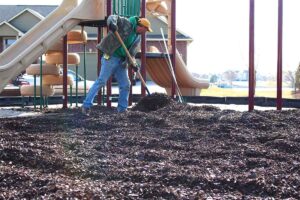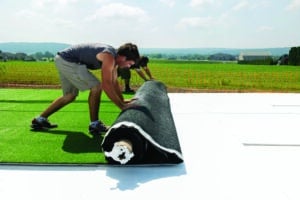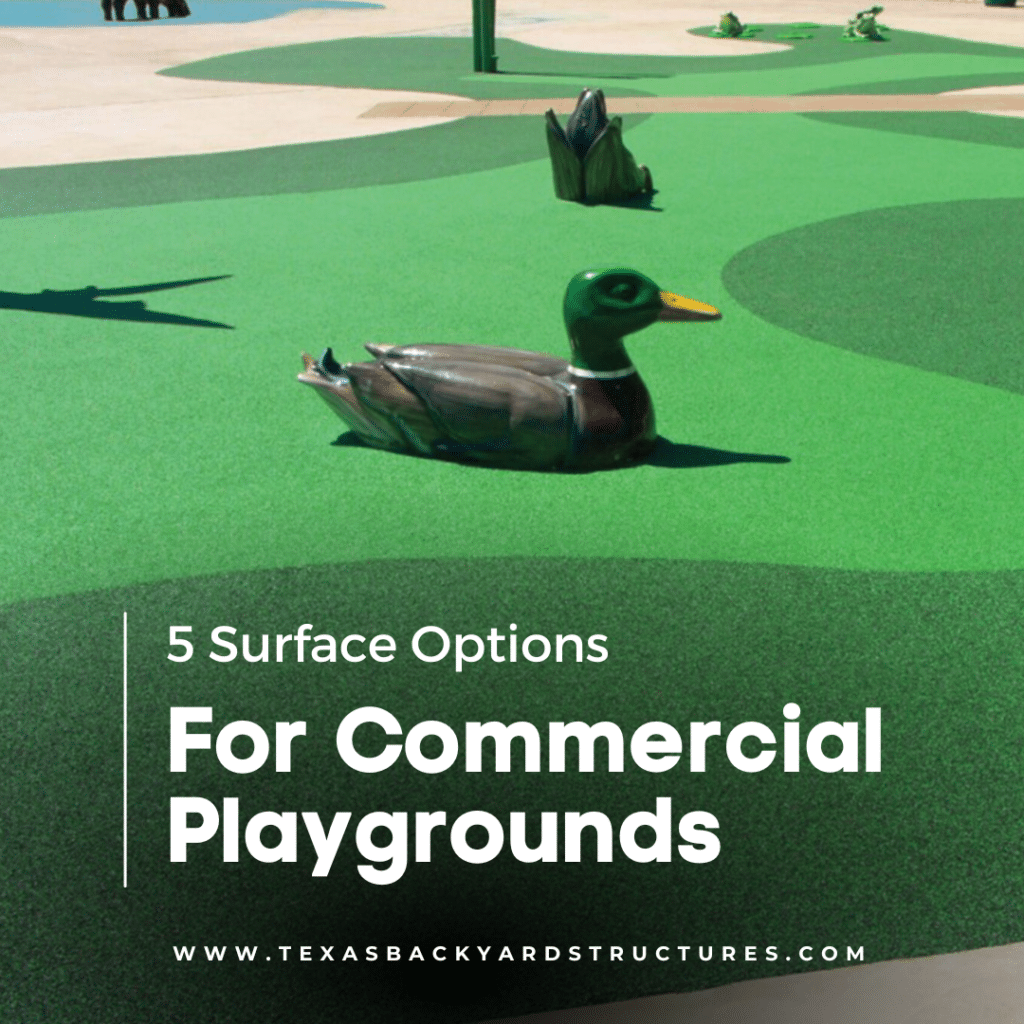Selecting the appropriate surfacing material for commercial playgrounds is crucial for ensuring safety, accessibility, durability, and overall user enjoyment. The surface material not only impacts the aesthetic appeal of the playground but also plays a significant role in injury prevention and maintenance requirements. This comprehensive guide explores the most common materials used for commercial playground surfaces, highlighting their advantages, disadvantages, and suitability for various environments.
1. Poured-in-Place Rubber
Overview: Poured-in-place (PIP) rubber is a seamless, unitary surfacing option composed of rubber granules bound together with polyurethane. This material is installed on-site, allowing for customization in thickness, color, and design.
Advantages:
-
Safety: Offers excellent impact attenuation, reducing the risk of injuries from falls.
-
Accessibility: Provides a smooth, wheelchair-accessible surface compliant with ADA standards.
-
Durability: Resistant to varying weather conditions and heavy foot traffic, ensuring longevity.
-
Customization: Allows for creative designs, incorporating patterns, games, or logos directly into the surface.
Disadvantages:
-
Cost: Higher initial investment compared to loose-fill materials.
-
Repair Complexity: Damage may require professional repair to maintain surface integrity and appearance.
Suitability: Ideal for playgrounds requiring a durable, low-maintenance, and accessible surface, such as urban parks, schools, and inclusive play areas.
2. Rubber Mulch
Overview: Rubber mulch is a loose-fill material made from recycled rubber, typically sourced from shredded tires. It provides a soft surface that mimics traditional wood mulch but with enhanced durability.

Advantages:
-
Safety: Offers good shock absorption, reducing the risk of injury from falls.
-
Durability: Does not decompose, retaining its form and color longer than organic mulches.
-
Maintenance: Requires less frequent replenishment compared to wood-based materials.
-
Environmental Impact: Utilizes recycled materials, contributing to waste reduction.
Disadvantages:
-
Initial Cost: Higher upfront cost than wood mulch.
-
Heat Retention: Can become hot in direct sunlight, potentially causing discomfort.
-
Ingestion Risk: Small pieces may pose a choking hazard if ingested by young children.
Suitability: Suitable for playgrounds seeking an eco-friendly, durable surfacing option with a natural aesthetic, such as community parks and recreational areas.
3. Engineered Wood Fiber (EWF)
Overview: Engineered wood fiber is a processed wood product designed specifically for playgrounds. It consists of shredded wood fibers that compact to form a stable, resilient surface.
Advantages:
-
Cost-Effective: Lower initial cost compared to unitary surfaces like PIP rubber.
-
Natural Appearance: Provides an organic look that blends well with outdoor environments.
-
Safety: Offers adequate impact absorption when properly maintained at recommended depths.
Disadvantages:
-
Maintenance: Requires regular raking and topping off to maintain appropriate depth and safety standards.
-
Accessibility: May not provide a consistently firm surface for wheelchair users without proper installation and maintenance.
-
Decomposition: Subject to natural decay, leading to potential mold or insect issues over time.
Suitability: Ideal for playgrounds with budget constraints desiring a natural look, such as daycare centers and neighborhood parks.
4. Artificial Turf
Overview: Artificial turf is a synthetic grass-like surface that provides the aesthetic appeal of natural grass without the extensive maintenance requirements.

Advantages:
-
Aesthetic Appeal: Offers a lush, green appearance year-round.
-
Low Maintenance: Eliminates the need for watering, mowing, or fertilizing.
-
Durability: Withstands heavy use and various weather conditions without significant wear.
-
Safety: Can be installed with an underlying shock-absorbing layer to enhance safety.
Disadvantages:
-
Heat Retention: Surface can become hot under direct sunlight, potentially causing discomfort.
-
Initial Cost: Higher installation costs compared to natural grass or loose-fill materials.
-
Environmental Concerns: Made from synthetic materials, raising questions about sustainability and end-of-life disposal.
Suitability: Suitable for playgrounds seeking a grass-like appearance with reduced maintenance, such as schoolyards and residential complexes.
5. Pea Gravel
Overview: Pea gravel consists of small, rounded stones commonly used as a loose-fill playground surface.
Advantages:
-
Cost-Effective: Generally affordable with low initial investment.
-
Drainage: Excellent drainage properties, preventing water accumulation.
-
Installation: Easy to install and replenish as needed.
Disadvantages:
-
Safety: Provides minimal impact absorption, increasing the risk of injury from falls.
-
Accessibility: Not suitable for wheelchair users, failing to meet ADA accessibility standards.
-
Maintenance: Prone to displacement, requiring regular raking to maintain an even surface.
Suitability: Best suited for playgrounds with low fall heights and limited budgets, where accessibility is not a primary concern.
Choosing the right commercial playground equipment surface is essential for ensuring safety, accessibility, durability, and long-term cost-effectiveness. Each surfacing material—whether poured-in-place rubber, rubber mulch, engineered wood fiber, artificial turf, or pea gravel—offers unique benefits and considerations.
For maximum safety and accessibility, poured-in-place rubber and artificial turf are excellent choices, providing a durable, low-maintenance surface. If you’re looking for a cost-effective yet reliable option, engineered wood fiber or rubber mulch may be ideal. However, materials like pea gravel and sand, while budget-friendly, may not meet modern safety and ADA compliance standards.
Ultimately, selecting the best playground surfacing depends on factors such as budget, location, intended usage, maintenance requirements, and compliance with safety regulations. By carefully evaluating these considerations, HOAs, schools, parks, and recreational facilities can create a safe, engaging, and long-lasting play environment for children of all ages.

